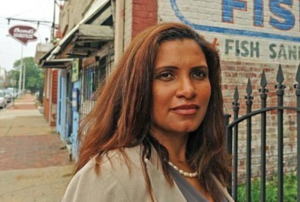by James A. Bacon
Kimberly Gray, a Richmond City Councilwoman and mayoral candidate, espouses a philosophy that some people in the era of Black Lives Matter find offensive. “I’ve been verbal about protecting all citizens,” she tells Bacon’s Rebellion. “This is my city. I love my city. I want it to be a place where everybody feels safe in their own homes, from Gilpin Court to Monument Avenue.”
That outlook has put her at odds with the social-justice protests sweeping the city that erupt episodically in looting, arson, vandalism, and confrontations with police. As an African-American, Gray is sympathetic with some of the protest movement’s aims, such as removing the Confederate statues from Monument Avenue. She also supports peoples’ Constitutional right to peaceful protest. But she has a problem with demonstrators toting semi-automatic weapons on her doorstep. And she is one of the few public figures in Richmond to forthrightly criticize the systemic use of low-level violence to intimidate and silence opponents.
Gray’s willingness to stand up to the mob has put her in the cross-hairs of the anarchic left-wing movement that has kept the City of Richmond on edge for more than two months. She was subjected to low-level harassment for weeks even before a crowd of roughly 200 descended upon her house in Jackson Ward last week, banged pots and pans, blew air horns, hurled insults, brandished guns, and shouted threats. That incident generated brief media attention when she complained that the Richmond Department of Police never dispatched officers to her residence.
In the Richmond mayoral race this year, Gray has been thrust into the position of defending law and order.
Several candidates are running for mayor of Richmond, but the political handicappers say it is a three-way race. Alexsis Rogers is running in the progressive lane, advocating more money for schools, environmental justice, and the partial defunding of the police. Mayor Levar Stoney, the incumbent, is threading the needle between social justice radicals and the political and business power structure. That leaves Gray, a vocal critic of Stoney’s Navy Hill downtown development scheme, positioned as the fiscal conservative, supporter of law enforcement, and champion of ordinary law-abiding citizens.
Gray is half white — the illegitimate daughter of a white woman and a black man — and was raised in the 1970s when Virginia was still wrestling with the demons of segregation. Her mother couldn’t keep her brother and her safe in the racist neighborhood where she lived, and, when Gray was two years old, the two children went to live with her father and his wife. Even then, she says, her father was targeted for harassment by the Klan. Although she identifies as an African-American, has African-American children, and supports African-American causes, she says she can represent people from a diversity of backgrounds. “I’m not a divider when it comes to race.”
She infuriated leftist militants in Richmond when she said on the radio that their intimidation tactics reminded her of when the KKK stalked her father. The Twitter Outrage Mob erupted with indignation over what it interpreted as Gray drawing a moral equivalence between them and the Klan. But she stands by her statement that their tactics — rule by intimidation — are similar.
“If you don’t go 100 percent with what they say, they come after you violently,” she says. “They’re suppressing other peoples’ first amendment rights. They are intimidating voters.”
When George Floyd was killed in Minneapolis by a policeman putting a knee on his neck, Gray was as distressed as anyone. But she had no sympathy for those who piggybacked on legitimate protests in Richmond to loot, burn and vandalize. The more she spoke out, the more the Twitter mob targeted her. As emotions flared over Civil War statues and policing practices, the conflict spilled over from cyberspace to the real world. She endured weeks, she says, of people stalking her house, hurling curses, trespassing onto her property and ripping out plants.
Gray shared with Bacon’s Rebellion a document, authored by “a local abolitionist and strategist,” urging activists to target people in power “who give you what you want.” Targets include Commonwealth Attorney Colette McEachin (mentioned by name), the mayor, and members of city council. The document listed several “direct action ideas” for making their lives miserable. (Gray asked Bacon’s Rebellion not to share the document or list the action items for fear of giving people ideas.) However, it is important to note that one of the direct actions urged: “Show up at targets house.”
In mid-June a crowd protested in front of Mayor Stoney’s apartment building; 20 to 30 demonstrators managed to pushed their way into the lobby. Several days later, a smaller group demonstrated in front of the house of Colette McEachin, Richmond Commonwealth Attorney and wife of Congressman Donald McEachin. Eleven people were arrested for picketing, one for obstructing justice, two for assaulting a law enforcement officer, and one for trespassing. The tactic of demonstrating in front of elected officials has become common across the country. A week ago, protesters targeted the homes of Fredericksburg’s major and city manager.
On July 15, a crowd assembled in Festival Park in downtown Richmond in the early evening. A couple of days before, someone had used bricks to knock out the security cameras at her house — an act that suggests premeditation and planning.
Richmond police knew of the gathering and monitored it from a distance. The RPD called Gray and conveyed a warning. Some members of the crowed had bats and sticks and guns. “They told me to go inside.”
Gray complied. She was worried. News reports from other cities indicated that left-wing militants had a propensity for violence. She had young children in the house and felt extremely vulnerable, even though a member of her security team — former policemen who had volunteered to look out for her — was on the premises. A Richmond police lieutenant did maintain telephone contact with her throughout the incident but, despite the RPD’s later assertions that police were on hand, she never saw a police car.
Marching from Festival Park, the crowd of about 200 protesters reached her house in historic Jackson Ward. They filled the block and cut off traffic. Demonstrators raised a clamor by banging pots and pans and blasting an air horn that sounded like a train. There was shouting and chanting, People yelled, “Come out! You’re a coward!” Her security guard heard someone shout, “Burn it down!” and “Burn the witch!” Some protesters were armed with semi-automatic weapons. Some aimed retina-burning lasers, including one or more on rifle scopes, into the house.
Gray says she has no idea who most of the protesters were, although she did recognize one — Chelsea Higgs-Wise, a high-profile supporter of competing mayoral candidate Alexsis Rogers. Higgs-Wise stood in front of the crowd shouting into a bullhorn.
Police later claimed that the protest lasted about 15 minutes. Gray says it lasted as least a half hour. Her daughter posted a 26-minute video on Facebook Live, and that didn’t capture the entire demonstration.
In Richmond, the neighborhood around the Lee statue, which protesters have claimed for their own, has become a virtual police-free zone. Police refuse to respond to routine incidents such as vandalism, excessive noise at late hours, and even occasional assaults. Police did react last night, however, after hundreds of protesters mobbed the downtown police headquarters, setting fire to a dump truck used to cordon off the area, burned a nearby restaurant, and taunted officers in an apparent attempt to goad them into an over-reaction. The police deployed tear gas and flash bangs to disperse the crowd.
Although the number of people bearing guns represent only a small percentage of the protesters, they are a source of concern to Gray. “People are handling their assault weapons with triggers engaged,” she has. “Many have hair triggers. It’s frightening to witness.”
She sparked controversy in 2017 when she advocated banning assault rifles when white supremacists were planning a rally in Richmond. “I’ve been consistent in my concerns about assault rifles in residential neighborhoods. … They can create mass carnage.”
While the police were willing to use force to disperse the mob in front of the RPD headquarters building, protesters are otherwise allowed to roam unchecked around the city. The RPD has adopted a policy of avoiding confrontation with the crowds, which means tolerating lesser crimes. As long as they aren’t assaulting people and burning things, protesters fear no retribution.
At great personal risk, Kim Gray is the only elected official calling them to account.




